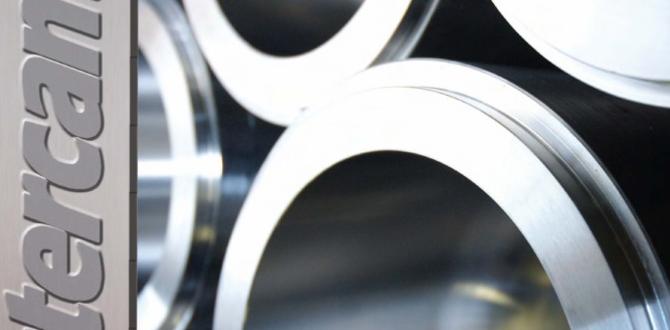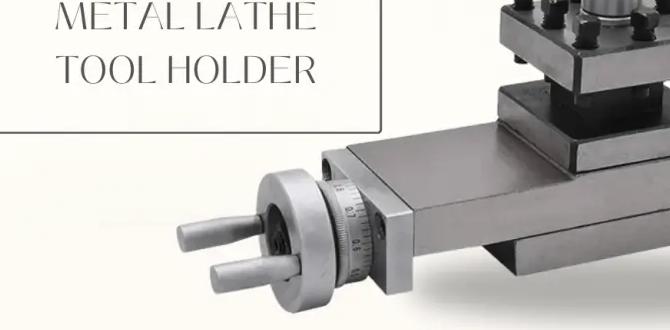A 1/8-inch carbide end mill, particularly one with an 8mm shank and a reduced neck, is a fantastic solution for wood chatter. Its design allows for a cleaner cut and deeper pockets, significantly reducing the vibration and fuzzy surface finish that plagues woodworking projects.
Ever struggled with that annoying fuzz or vibration when milling wood? It’s called chatter, and it can turn a smooth wood project into a frustrating mess. Many makers, especially those new to the milling machine, face this common problem. It looks bad and makes your work harder. But don’t worry! There’s a smart tool that can help: the 1/8-inch carbide end mill. We’re going to explore just how this specific tool can be your secret weapon against wood chatter.
Understanding Wood Chatter and Why It Happens
Chatter, in the world of milling, is basically unwanted vibration. When your end mill spins, it bites into the wood. If the conditions aren’t quite right, the cutting edge can bounce, causing it to repeatedly engage and disengage the material in a rapid, irregular rhythm. This leads to a rough, wavy surface finish that’s definitely not what we’re aiming for. It’s like a tiny earthquake happening under your cutting tool!
Several factors contribute to wood chatter:
- Tool Deflection: The cutting forces can bend the end mill, especially longer or thinner ones, causing them to flex and vibrate.
- Feed Rate and Spindle Speed: Cutting too fast or too slow, or at the wrong spindle speed (RPM), can excite resonant frequencies in the tool and workpiece, leading to chatter.
- Material Properties: Different types of wood, their density, and grain structure can influence how they react to cutting forces.
- Machine Rigidity: A less rigid milling machine or a loose workpiece mount can easily amplify vibrations.
- Tool Condition: Dull or damaged cutting edges can also contribute to rough cuts and chatter.
For beginners, figuring out the perfect combination of settings can feel like a guessing game. But understanding the root causes helps us choose the right tools and techniques to combat them directly.
Why a 1/8-Inch Carbide End Mill?
So, why a 1/8-inch carbide end mill, and what makes it so special for wood? Let’s break it down:
The Importance of Size: 1/8 Inch
The 1/8-inch diameter is a sweet spot for many detailed woodworking projects. It’s small enough to create intricate designs, letters, or small features. Think about engraving delicate patterns, milling small cavities for inlays, or cutting precise joinery. A smaller diameter allows for:
- Fine Detail: Accessing tight corners and creating very fine lines.
- Reduced Cutting Force: Smaller diameter tools generally require less force to cut, which can reduce the tendency for the tool to deflect and vibrate.
- Better Chip Evacuation: With appropriate settings, smaller flutes can help in clearing chips from the cutting area, which is crucial for a clean cut.
Material Matters: Carbide
Carbide is a super-hard material that’s significantly harder and more wear-resistant than high-speed steel (HSS). For milling wood, this offers several advantages:
- Durability: Carbide cutters stay sharp much longer, even when cutting harder woods or composites. This means more consistent cutting performance and less chance of dullness contributing to chatter.
- Heat Resistance: They handle the heat generated during cutting better, which is important for maintaining edge integrity.
- Smooth Finish: A sharp, durable carbide edge will typically produce a cleaner cut than a duller HSS tool, reducing the fuzzy texture associated with chatter.
The “Genius” Features: 8mm Shank and Reduced Neck
Now, let’s talk about the specific features that make this type of end mill a “genius” solution for wood chatter:
The 8mm Shank Advantage
You might notice that while the cutting diameter is 1/8 inch, the shank (the part that goes into the collet or tool holder) is often 8mm. This seemingly odd combination is a clever design choice:
- Increased Rigidity: An 8mm shank is significantly more robust than a 1/8-inch shank. This beefier shank provides a much stiffer connection to the spindle, greatly reducing tool flex and vibration. A more rigid setup means less deflection, which is a direct enemy of chatter.
- Compatibility: Many common CNC routers and machines use 8mm collets. This makes the tool readily compatible with a wide range of setups without needing specialized adapters.
Reduced Neck for Deeper Cuts
This is perhaps the most crucial feature for tackling chatter, especially when you need to mill deeper pockets or slots. A “reduced neck” or “neck relief” means that a portion of the tool shank, just above the cutting flutes, is machined down to a smaller diameter. Why is this a game-changer?
- Clearance for Chips: The reduced neck provides extra space for wood chips to evacuate from the bottom of the cut. When milling deep slots, chips can get packed in, leading to chip recutting and increased friction, both of which can cause chatter. The relieved neck allows chips to flow out more freely.
- Access to Confined Spaces: This feature is particularly useful for milling deep pockets. Without it, the shank could rub against the sides of the pocket as the cutter gets deeper, creating more friction and potential. The reduced neck eliminates this interference.
- Less Material Engagement at Depth: By having a diameter smaller than the cutting flutes just above them, the reduced neck can help to slightly reduce the amount of material being engaged at the very bottom of a deep cut, leading to a smoother finish.
Think of it like this: the extra clearance means the tool doesn’t have to fight its way out of a crowded pocket. It can cut more cleanly and with less stress, which translates directly into less vibration.
Using Your 1/8-Inch Carbide End Mill Effectively
Having the right tool is only half the battle. Here’s how to maximize its effectiveness and minimize wood chatter:
Step-by-Step Guide to Reducing Chatter
1. Secure Your Workpiece
This is paramount for any milling operation. Ensure your workpiece is firmly clamped or held down. Any movement of the material will amplify vibrations. Use double-sided tape for lighter jobs, but clamps are usually best for anything substantial. A solid foundation is key!
2. Choose the Right Spindle Speed (RPM)
Finding the sweet spot for RPM can be tricky and depends on your machine, the wood, and the end mill. As a starting point:
- Softer Woods: You might be able to run higher RPMs (e.g., 18,000 – 24,000 RPM).
- Harder Woods: Lower RPMs are often better to prevent burning and reduce chatter (e.g., 12,000 – 18,000 RPM).
Listen to the cut. If you hear a high-pitched whine or a chattering noise, your RPM might be too high or too low, or your feed rate is off. Experimentation is key. Many CNC controller software packages have calculators, and reputable manufacturers often provide suggested starting points. For example, the American Woodworking Machinery & Equipment Institute (AWMI) provides guidelines for tooling, though specific recommendations for 1/8″ mills in wood vary greatly.
3. Set the Correct Feed Rate
The feed rate is how fast the cutter moves through the material. A general rule of thumb for wood with a 1/8-inch mill is to start conservatively and increase gradually:
- Start Slow: Begin with a slow feed rate (e.g., 20-50 inches per minute or 500-1200 mm per minute) and increase it if the cut is clean and you don’t hear chatter.
- Listen to the Cut: A good feed rate should sound like a consistent “whoosh” or light crunching noise. A high-pitched squeal often means you’re too fast or your RPM is too high. A tearing or fuzzy sound can indicate you’re too slow or the cutter is dull.
- Chip Load: A more advanced concept is “chip load,” which is the thickness of the chip each cutting edge is removing. For a 1/8-inch 2-flute end mill in wood, a target chip load might be around 0.003 to 0.006 inches. Your feed rate is calculated as RPM x Number of Flutes x Chip Load.
4. Control Chip Evacuation
As mentioned, chip evacuation is critical.
- Don’t Overload Flutes: Avoid making cuts that are too deep or too wide for the flutes to handle.
- Air Blast or Vacuum: For deeper cuts, consider using an air blast or dust collection to help clear chips from the cutting zone.
- Stepovers: When milling wide areas, use a stepover of less than 50% of the tool diameter to ensure clean cuts.
5. Plunge Rate for Entry
When plunging (feeding straight down into the material), use a much slower feed rate than your cutting feed rate. This prevents the tool from digging in too aggressively and causing vibration or breakage. A plunge rate of 10-20 inches per minute is often a good starting point.
6. Climb Milling vs. Conventional Milling
For wood, climb milling (where the cutter rotates in the same direction as the feed) can often produce a smoother finish and reduce chatter compared to conventional milling. However, it requires a more rigid machine and can sometimes lead to the cutter “climbing” the material if not set up carefully. Always ensure your machine is capable and that you’re aware of the risks.
7. Toolpath Strategy
Consider how you’re milling the part. For pockets, a “pocketing” toolpath that mills from the outside in or spirals inward is generally better than trying to brute-force it. For slots, a simple “contour” or “slotting” toolpath works.
Essential Setup and Tooling
To get the best results, ensure you have the right supporting elements:
- Collet and Spindle: A clean, well-fitting collet is essential. A worn collet can cause runout (wobble), which is a major contributor to chatter.
- Workholding: As mentioned, extremely critical. CNC machine beds, vises, or jigs need to be robust.
- Dust Collection: While not directly about chatter, good dust collection helps keep your workspace clean and can assist in clearing chips.
Benefits of Using a 1/8-Inch Carbide End Mill for Wood
When used correctly, this specialized end mill offers some fantastic advantages:
- Dramatic Reduction in Chatter: This is the primary benefit. The combination of a small diameter, carbide hardness, robust shank, and relieved neck drastically reduces the tendency for vibration.
- Superior Surface Finish: Expect smoother surfaces with less fuzz and tearing. This means less sanding and finishing work later.
- Increased Precision: The rigidity and sharpness allow for more accurate cuts, essential for detailed work.
- Longer Tool Life: Carbide stays sharp longer than HSS, giving you consistent performance over many projects.
- Ability to Mill Deeper Pockets: The primary function of the reduced neck is to allow for deeper, cleaner cuts without interference.
Potential Drawbacks / Things to Watch Out For
While fantastic, it’s not a magic bullet for every situation. Here’s what to be aware of:
- Cost: Carbide end mills, especially specialized ones, are more expensive upfront than basic HSS bits.
- Brittleness: Carbide can be brittle. If you crash the tool (hit something it shouldn’t), it’s more likely to chip or break than a flexible HSS tool.
- Feed Rate Sensitivity: Because they’re so hard, they can burn wood if the feed rate is too slow for the RPM.
- Not for All Woods: Extremely exotic or abrasive woods might still pose challenges, but this tool is a great starting point.
When to Consider Alternatives
In some cases, you might need a different tool:
- Very Large Areas: For clearing large areas quickly, a larger diameter end mill (1/4″ or 1/2″) will be more efficient.
- Extremely Delicate Work: For the absolute finest detail on very soft materials, a micro-end mill designed specifically for such tasks might be better, though these are less common for general woodworking.
- Very Abrasive Materials: For materials like MDF or certain composite panels that are highly abrasive, diamond-coated or specialized PCD (Polycrystalline Diamond) tooling might be necessary for extreme longevity, though carbide is generally excellent for wood.
Comparison: 1/8-Inch Carbide End Mill vs. Other Options
To help solidify why this tool is so good, let’s compare it:
| Feature | 1/8″ Carbide End Mill (Reduced Neck, 8mm Shank) | 1/8″ HSS End Mill | Larger Diameter End Mill (e.g., 1/4″ Carbide) |
|---|---|---|---|
| Chatter Resistance | Excellent | Fair to Poor | Good (but less detail) |
| Detail Capability | Excellent | Good | Fair |
| Surface Finish | Excellent | Good to Fair | Good to Very Good |
| Tool Life | Very Good | Fair | Very Good |
| Deep Pocket Milling | Excellent (due to relieved neck) | Fair (limited by deflection and chip clearance) | Very Good (but less suitable for small pockets) |
| Cost | Moderate to High | Low | Moderate to High |
This table highlights that for the specific niche of detailed woodworking where chatter is a problem and deeper pockets are needed, the 1/8-inch carbide end mill with a reduced neck and an 8mm shank truly stands out.
Where to Find Reliable End Mills
When looking for a quality 1/8-inch carbide end mill, particularly one with a reduced neck and an 8mm shank for wood, consider these resources:
- Specialty CNC Tooling Suppliers: Companies that focus on CNC router bits and end mills often carry these types of specialized tools.
- Woodworking Tool Retailers: Larger, well-stocked woodworking stores may have a section for CNC tooling.
- Online Marketplaces: Websites like Amazon, eBay, and dedicated woodworking forums often have listings. Be sure to check reviews and seller reputation.
- Manufacturer Websites: Directly checking the websites of reputable tool manufacturers (e.g., Onsrud, Whiteside, Amana Tool) can lead you to their product lines.
Look for descriptions that specifically mention “reduced neck,” “neck relief,” or are designed for “pocketing” or “3D carving” in wood. For example, tools designed for detailed CNC carving, like those you might find recommended by CNC Router Parts (a reputable supplier in the hobbyist CNC space), often feature these characteristics.
Frequently Asked Questions (FAQ)
What is the best RPM for a 1/8-inch carbide end mill in soft wood?
For soft woods like pine or poplar, you can often push the RPM higher, typically between 18,000 and 24,000 RPM. Always start at the lower end of this range and listen to your machine, adjusting as needed. Too high an RPM can lead to burning if your feed rate isn’t sufficient.
How do I prevent burning with a 1/8-inch carbide end mill?
Burning is usually caused by heat buildup. This can happen if you’re feeding too slowly, taking cuts that are too deep, or if your RPM is too high for the feed rate. Ensure a proper chip load, maintain a consistent feed rate, and use an appropriate RPM. If you’re seeing burn marks, try increasing your feed rate slightly or reducing your RPM.
Can I use this end mill for aluminum?
While carbide is hard, a 1/8-inch end mill, even with a reduced neck and 8mm shank, is primarily designed for wood. Milling aluminum requires specialized aluminum-cutting end mills with geometries designed to handle metal’s properties, usually with fewer flutes





